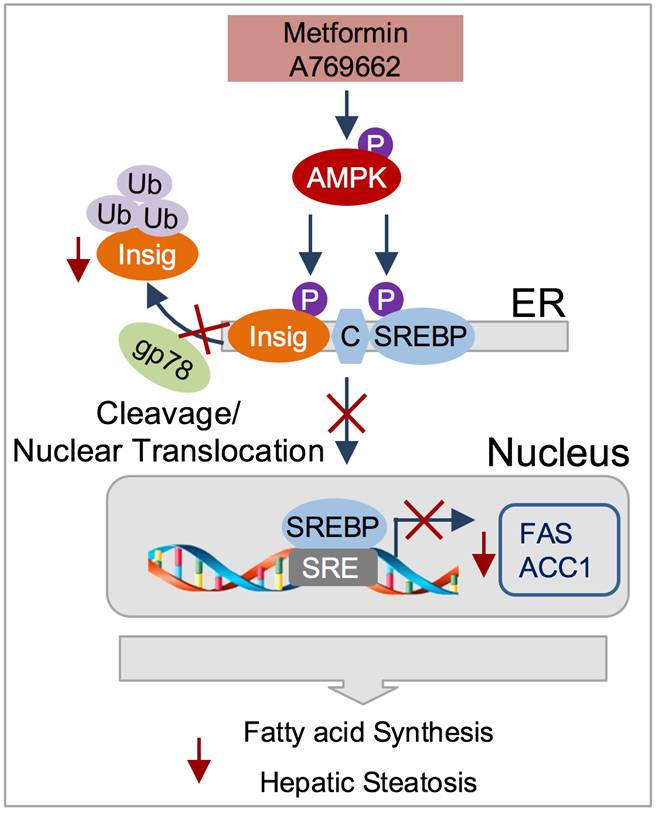
Insulin-induced gene (Insig) is a key regulator for the negative regulation of SREBP-1c-mediated de novo fatty acid synthesis in the liver. However, the upstream signaling that mediates the post-translational regulation of Insig is poorly understood.
In a recent study published online in Nature Communications, a team of scientists led by Prof. LI Yu from Shanghai Institute of Nutrition and Health of Chinese Academy of Sciences demonstrated that AMPK phosphorylates Insig and represses its ubiquitination and degradation via inhibiting the interaction between Insig and the ubiquitin ligase gp78, which prevents the proteolytic processing and activation of SREBP-1c.
Moreover, they found that the beneficial effects of metformin on hepatic steatosis are partially mediated by activation of Insig.
Scientists provided gain- and loss-of-function evidence to characterize Insig as a critical effector in mediating AMPK and its agonist metformin in regulating lipogenesis and maintaining hepatic lipid metabolism.
Thr222 phosphorylation of Insig-1 by AMPK is required for the protein stabilization of Insig-1 and inhibition of cleavage and processing of SREBP-1 and lipogenic gene expression in response to metformin or A769662.
AMPK phosphorylation of Insig ablates its interaction with E3 ubiquitin ligase gp78 and represses its ubiquitination and degradation, whereas AMPK deficiency has opposite effects.
Hepatic activation of AMPK by metformin is sufficient to reverse gp78-mediated reduction of Insig expression, represses SREBP-1 target gene expression, and protects against hepatic steatosis in high-fat, high sucrose (HFHS) diet-induced insulin resistant mice.
The results delineated the mechanism of post-translational regulation of Insig. Targeting Insig has therapeutic potential for treating fatty liver disease and related metabolic disorders.
Together with the team's finding that metabolic regulator CREBZF inhibits Insig at transcriptional level and contributes to enhanced hepatic lipogenesis in response to insulin (Zhang F, et al, Hepatology, 2018), CREBZF- and AMPK-mediated transcriptional and post-translational regulation of Insig was revealed to play essential roles in the regulation of lipid metabolism in the liver, and the dynamic regulation of cellular Insig activity was found to provide a finely tuned mechanism for the cellular regulation of hepatic lipid homeostasis by this study.
The studies provide therapeutic strategies for treating nonalcoholic fatty liver disease, insulin resistance and type 2 diabetes.

The proposed model for the post-translational regulation of Insig by AMPK Phosphorylation: targeting Insig may have the therapeutic potential for treating fatty liver disease and related metabolic disorders. (Image by Dr. LI Yu’s lab)

86-10-68597521 (day)
86-10-68597289 (night)

86-10-68511095 (day)
86-10-68512458 (night)

cas_en@cas.cn

52 Sanlihe Rd., Xicheng District,
Beijing, China (100864)

